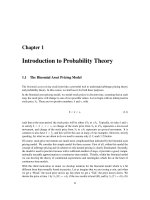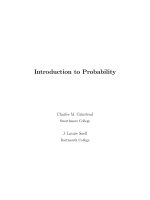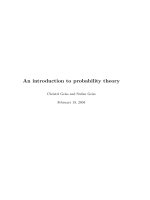Introduction to Probability
Bạn đang xem bản rút gọn của tài liệu. Xem và tải ngay bản đầy đủ của tài liệu tại đây (2.72 MB, 61 trang )
IntroductiontoProbability
ProbabilityExamplesc-1
LeifMejlbro
Downloadfreebooksat
Leif Mejlbro
Probability Examples c-1
Introduction to Probability
2
Download free eBooks at bookboon.com
Probability Examples c-1 – Introduction to Probability
© 2009 Leif Mejlbro & Ventus Publishing ApS
ISBN 978-87-7681-515-8
3
Download free eBooks at bookboon.com
Introduction to Probability
Contents
Contents
Introduction
5
1
Some theoretical background
6
2
Set theory
10
3
Sampling with and without replacement
12
4
Playing cards
19
5
Miscellaneous
27
6
Binomial distribution
35
7
Lotto
38
8
Huyghens’ exercise
39
9
Balls in boxes
41
10
Conditional probabilities, Bayes’s formula
42
11
Stochastic independency/dependency
48
12
Probabilities of events by set theory
51
13
The rencontre problem and similar examples
53
14
Strategy in games
57
15
Bertrand’s paradox
59
Index
61
www.sylvania.com
We do not reinvent
the wheel we reinvent
light.
Fascinating lighting offers an ininite spectrum of
possibilities: Innovative technologies and new
markets provide both opportunities and challenges.
An environment in which your expertise is in high
demand. Enjoy the supportive working atmosphere
within our global group and beneit from international
career paths. Implement sustainable ideas in close
cooperation with other specialists and contribute to
inluencing our future. Come and join us in reinventing
light every day.
Light is OSRAM
4
Click on the ad to read more
Download free eBooks at bookboon.com
Introduction
Introduction to Probability
Introduction
This is the first book of examples from the Theory of Probability. This topic is not my favourite,
however, thanks to my former colleague, Ole Jørsboe, I somehow managed to get an idea of what it is
all about. The way I have treated the topic will often diverge from the more professional treatment.
On the other hand, it will probably also be closer to the way of thinking which is more common among
many readers, because I also had to start from scratch.
Unfortunately errors cannot be avoided in a first edition of a work of this type. However, the author
has tried to put them on a minimum, hoping that the reader will meet with sympathy the errors
which do occur in the text.
Leif Mejlbro
25th October 2009
5
Download free eBooks at bookboon.com
1. Some theoretical beckground
Introduction to Probability
1
Some theoretical background
It is not the purpose here to produce a full introduction into the theory, so we shall be content just
to mention the most important concepts and theorems.
The topic probability is relying on the concept σ-algebra. A σ-algebra is defined as a collection F of
subsets from a given set Ω, for which
1) The empty set belongs to the σ-algebra, ∅ ∈ F.
2) If a set A ∈ F, then also its complementary set lies in F, thus ∁A ∈ F.
3) If the elements of a finite or countable sequence of subsets of Ω all lie in F, i.e. A n ∈ F for e.g.
n ∈ N, then the union of them will also belong to F, i.e.
+∞
An ∈ F.
n=1
The sets of F are called events.
We next introduce a probability measure on (Ω, F) as a set function P : F → R, for which
1) Whenever A ∈ F, then 0 ≤ P (A) ≤ 1.
2) P (∅) = 0 and P (Ω) = 1.
3) If (An ) is a finite or countable family of mutually disjoint events, e.g. Ai ∩ Aj = ∅, if i = j, then
+∞
+∞
An
P
n=1
=
P (An ) .
n=1
All these concepts are united in the Probability field, which is a triple (Ω, F, P ), where Ω is a (nonempty) set, F is a σ-algebra of subsets of Ω, and P is a probability measure on (Ω, F).
We mention the following simple rules of calculations:
If (Ω, F, P ) is a probability field, and A, B ∈ F, then
1)
P (B) = P (A) + P (B\) ≥ P (A),
if A ⊆ B.
2)
P (A ∪ B) = P (A) + P (B) − P (A ∩ B).
3)
P (∁A) = 1 − P (A).
4)
If A1 ⊆ A2 ⊆ · · · ⊆ An ⊆ · · · and A =
+∞
An ,
then
P (A) = lim P (An ) .
An ,
then
P (A) = lim P (An ) .
n→+∞
n=1
+∞
5)
If A1 ⊇ A2 ⊇ · · · ⊇ An ⊇ · · · and A =
n=1
6
Download free eBooks at bookboon.com
n→+∞
1. Some theoretical beckground
Introduction to Probability
Let (Ω, F, P ) be a probability field, and let A and B ∈ F be events where we assume that P (B) > 0.
We define the conditional probability of A, for given B by
P (A | B) :=
P (A ∩ B)
.
P (B)
In this case, Q, given by
Q(A) := P (A | B),
A ∈ F,
is also a probability measure on (Ω, F).
The multiplication theorem of probability,
P (A ∩ B) = P (B) · P (A | B).
360°
thinking
.
Discover the truth at www.deloitte.ca/careers
© Deloitte & Touche LLP and affiliated entities.
7
Click on the ad to read more
Download free eBooks at bookboon.com
1. Some theoretical beckground
Introduction to Probability
Two events A and B are called independent, if P (A | B) = P (A), i.e. if
P (A ∩ B) = P (A) · P (B).
We expand this by saying that n events Aj , j = 1, . . . , n, are independent, if we for any subset
J ⊆ {1, . . . , n} have that
⎞
⎛
P⎝
j∈J
Aj ⎠ =
P (Aj ) .
j∈J
We finally mention two results, which will become useful in the examples to come:
+∞
Given (Ω, F, P ) a probability field. We assume that we have a splitting (Aj )j=1 of Ω into events
Aj ∈ F, which means that the Aj are mutually disjoint and their union is all of Ω, thus
+∞
Aj = Ω,
and
Ai ∩ Aj = ∅,
for every pair of indices (i, j), where i = j.
j=1
If A ∈ F is an event, for which P (A) > 0, then
The law of total probability,
+∞
P (Aj ) · P (A | Aj ) ,
P (A) =
j=1
and
Bayes’s formula,
P (Ai | A) =
P (Ai ) · P (A | Ai )
+∞
j=1
P (Aj ) · P (A | Aj )
.
8
Download free eBooks at bookboon.com
2. Set theory
Introduction to Probability
2
Set theory
Example 2.1 Let A1 , A2 , . . . , An be subsets of the sets Ω. Prove that
n
n
∁
∁Ai
og
i=1
i=1
n
n
∁Ai
=
Ai
∁Ai .
=
i=1
i=1
These formulæ are called de Morgan’s formulæ.
n
1a. If x ∈ ∁ ( i=1 Ai ), then x does not belong to any Ai , thus x ∈ ∁Ai for every i, and therefore also
in the intersection, so
n
n
∁
∁Ai .
Ai
i=1
i=1
n
1b. On the other hand, if x ∈ i=1 ∁Ai , then x lies in all complements ∁Ai , so x does not belong to
any Ai , and therefore not in the union either, so
n
n
∁Ai
∁
i=1
Ai
.
i=1
Summing up we conclude that we have equality.
2. If we put Bi = ∁Ai , then ∁Bi = ∁∁Ai = Ai , and it follows from (1) that
n
∁
n
∁Bi
i=1
=
Bi .
i=1
Then by taking the complements,
n
n
∁Bi = ∁
i=1
Bi
i=1
We see that (2) follows, when we replace Bi by Ai .
Example 2.2 Let A and B be two subsets of the set Ω. We define the symmetric set difference AΔB
by
AΔB = (A \ B) ∪ (B \ A).
Prove that
AΔB = (A ∪ B) \ (A ∩ B).
Then let A, B and C be three subsets of the set Ω. Prove that
(AΔB)ΔC = AΔ(BΔC).
9
Download free eBooks at bookboon.com
2. Set theory
Introduction to Probability
A minus B
A f lles B
B minus A
Figure 1: Venn diagram for two sets.
The claim is easiest to prove by a Venn diagram. Alternatively one may argue as follows:
1a. If x ∈ (A \ B) ∪ (B \ A), then x either lies in A, and not in B, or in B and not in A. This means
that x lies in one of the sets A and B, but not in both of them, hence
AΔB = (A \ B) ∪ (B \ A)
(A ∪ B) \ (A ∩ B).
1b. Conversely, if x ∈ (A ∪ B) \ (A ∩ B), and A = B, then x must lie in one of the sets, because
x ∈ A ∪ B and not in both of them, since x ∈
/ A ∩ B, hence
(A ∪ B) \ (A ∩ B)
(A \ B) ∪ (B \ A) = AΔB.
1c. Finally, if A = B, then it is trivial that
AΔB = (A \ B) ∪ (B \ A) = ∅ = (A ∪ B) \ (A ∩ B).
Summing up we get
AΔB = (A \ B) ∪ (B \ A) = (A ∪ B) \ (A ∩ B).
2. If x ∈ AΔB, then x either lies in A or in B, and not in both of them. Then we have to check two
possibilities:
(a) If x ∈ (AΔB)ΔC and x ∈ (AΔB), then x does not belong to C, and precisely to one of the
sets A and B, so we even have with equality that
{(AΔB)ΔC} ∩ (AΔB) = (A \ (B ∪ V )) ∪ (B \ (A ∪ C)).
10
Download free eBooks at bookboon.com
2. Set theory
Introduction to Probability
A
B
D
C
Figure 2: Venn diagram of three discs A, B, C. The set (AΔB)ΔC is the union of the domains in
which we have put one of the letters A, B, C and D.
(b) If instead x ∈ (AΔB)ΔC and x ∈ C, then x does not belong to AΔB, so either x does not
belong to any A, B, or x belongs to both sets, so we obtain with equality,
{(AΔB)ΔC} ∩ C = {C \ (A ∪ B)} ∪ {A ∪ B ∪ C}.
Summing up we get
(AΔB)ΔC
= (A \ (B ∪ C))
∪ (B \ (A ∪ C))
∪ (C \ (A ∪ B))
∪ (A ∩ B ∩ C)
only contained in A,
only contained in B,
only contained in C,
contained in all three sets.
By interchanging the letters we get the same right hand side for AΔ(BΔC), hence
(AΔB)ΔC = AΔ(BΔC).
11
Download free eBooks at bookboon.com









